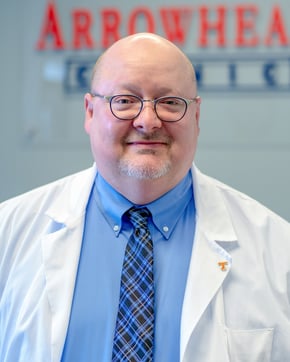7 Ways to Treat Lower Back Pain Other Than Painkillers
If you're like one of the many people on this planet, you've experienced low back pain at some point in your life.
Only 20% of the world's population will NOT experience low back pain during their lifetime.
If you're one of those lucky few, skip this article. It's not for you. You've been blessed, and we are jealous.
If you have experienced low back pain, or expect to, then this blog is for you.
In this blog, we will go over seven techniques for relieving lower back pain that do not involve painkillers.
Table of contents:
- 7 treatments for low back pain that don't involve painkillers
- Out with the old, in with the new
- 7 alternatives to painkillers for low back pain
- The new way of thinking
- There will be challenges
- Time to heal with Arrowhead Clinic
- Free Chiropractic Consultation
Luckily, low back pain is short-lived and goes away as quickly as it came in.
Unfortunately, once you have it, it tends to come back.
Typically when you start experiencing the pain, you head into your family doctor, and they will prescribe you some pain pills to ease the pain.
However, moving forward, that may no longer be the case.
Out With The Old, In With The New
Because of recent changes to the international guidelines for the management of LBP (low back pain) your doctor is now unlikely to recommend pain medications.
Up until this point, pain medications have been the go-to treatment for low back pain.
Worldwide, low back pain is the leading cause of disability.
In the US, back pain accounts for more than 264 million lost work days in one year.
That’s two work days for every full-time worker in the country.
Behind skin disorders and osteoarthritis/joint disorders, back pain is the third most common reason to visit your doctor.
Back pain is a serious issue, and there needs to be treatments that work.
The new guidelines were established by the American College of Physicians and the UK National Institute for Health and Care Excellence.
They encourage a shift in the way doctors think about the primary care management for low back pain.
This shift is largely due in part to the escalating prescription opioid crisis.
In 2017, more than 72,000 people died from drug overdoses, so if there's a treatment plan that doesn't involve opioids, it should be looked into.
Along with the opioid crisis, there's an overwhelming amount of research that shows that most pain medicines have little to no effect compared to placebos.
So you could be subjecting your body to those powerful painkillers for nothing.
That's why the guidelines have made a radical change in their stance on painkillers.
7 Alternatives to Pain Killers for Low Back Pain
- Yoga
- Mindfulness
- Heat
- Massage
- Physiotherapy
- Psychological therapies
- Exercise
The New Way Of Thinking
Instead of prescribing all of those painkillers, your doctor is more likely to suggest non-medicinal approaches.
Yoga, mindfulness, and various types of physiotherapy and psychological therapies may soon outnumber pain killer prescriptions.
The recommended approach of prescribing medicines like paracetamol or anti-inflammatories will soon be a thing of the past.
The new guidelines will suggest avoiding pain medications initially and will discourage other more invasive treatments like injections and surgery.
These new guidelines are very important and represent a significant change in thinking about low back pain.
The decades-old recommendations may soon be a thing of the past.
With most uncomplicated cases of recent-onset LBP, your doctor can now provide advice on how to remain active and non-drug methods for pain relief.
Heat and massage are likely treatments, and then your doctor will schedule a follow-up appointment to see how your body has responded.
If you've had LBP for an extended period, treatments such as yoga, exercise, and mindfulness are likely to be recommended.
Other effective options include spinal manipulation by your chiropractor, acupuncture, or other multi-disciplinary programs.
The changes to the international guidelines should affect treatment for low back pain worldwide.
There Will Be Challenges
There won't be a clean break between the pain killer treatment, and the new guidelines for treatment.
Friday your doctor won't be prescribing painkillers, and then Monday he's prescribing yoga.
There will be a transition period. There will also be challenges.
Right now, it's much easier and cheaper to provide a prescription for opioid pain medicine, even though it's not a long term fix than treatment with a physiotherapist or psychologist.
Health systems in most industrialized countries aren't set up to fund the care that is considered the most appropriate for low back pain right now.
Until there are policy changes, it's going to be difficult for your doctor to follow the new guidelines.
However, when the insurance companies and Medicare make simple changes to improve the affordability of the alternatives, implementing the new guidelines will be much easier.
It will also result in a major impact on the lives of those living with low back pain, especially those relying on opioids.
The Federal Government needs to pay close attention to these guidelines.
They will not only save lives of people addicted to opioids, but they will improve the lives of people suffering from low back pain.
Time To Heal with Arrowhead Clinic!
Even though the new guidelines may not be widespread yet, you can still find relief from your back pain without opioids.
One of the recommended alternatives, spinal adjustments, are easily accessible already at your local chiropractor's office.
If you're tired of taking pain killer after pain killer and want another way to treat your back pain, it might be time to see the chiropractors at the Arrowhead Clinic.
The doctors at the Arrowhead Clinic have years of experience dealing with low back pain and would be more than happy to help you out with yours.
If you're ready to get started, click the banner below.



